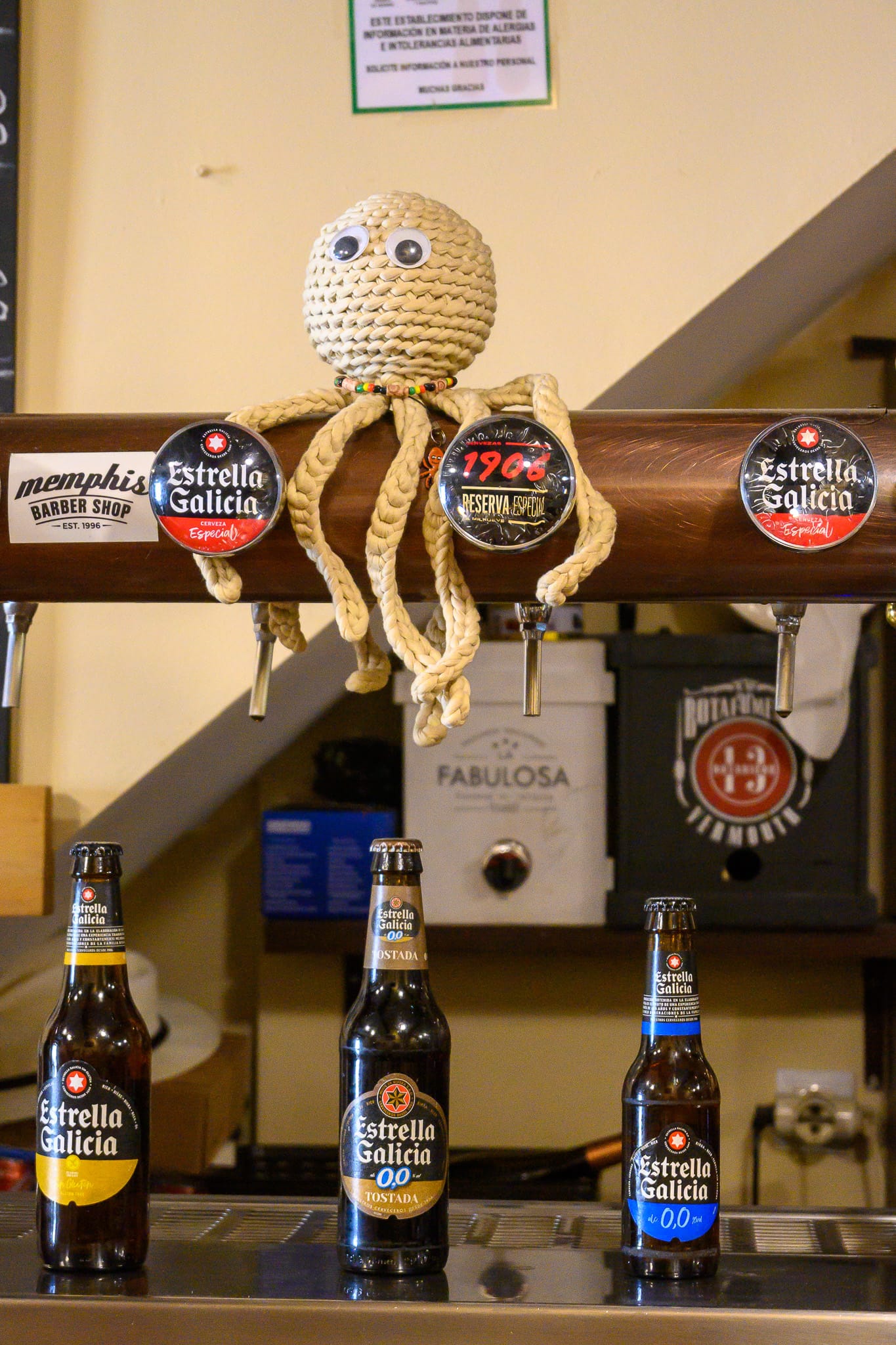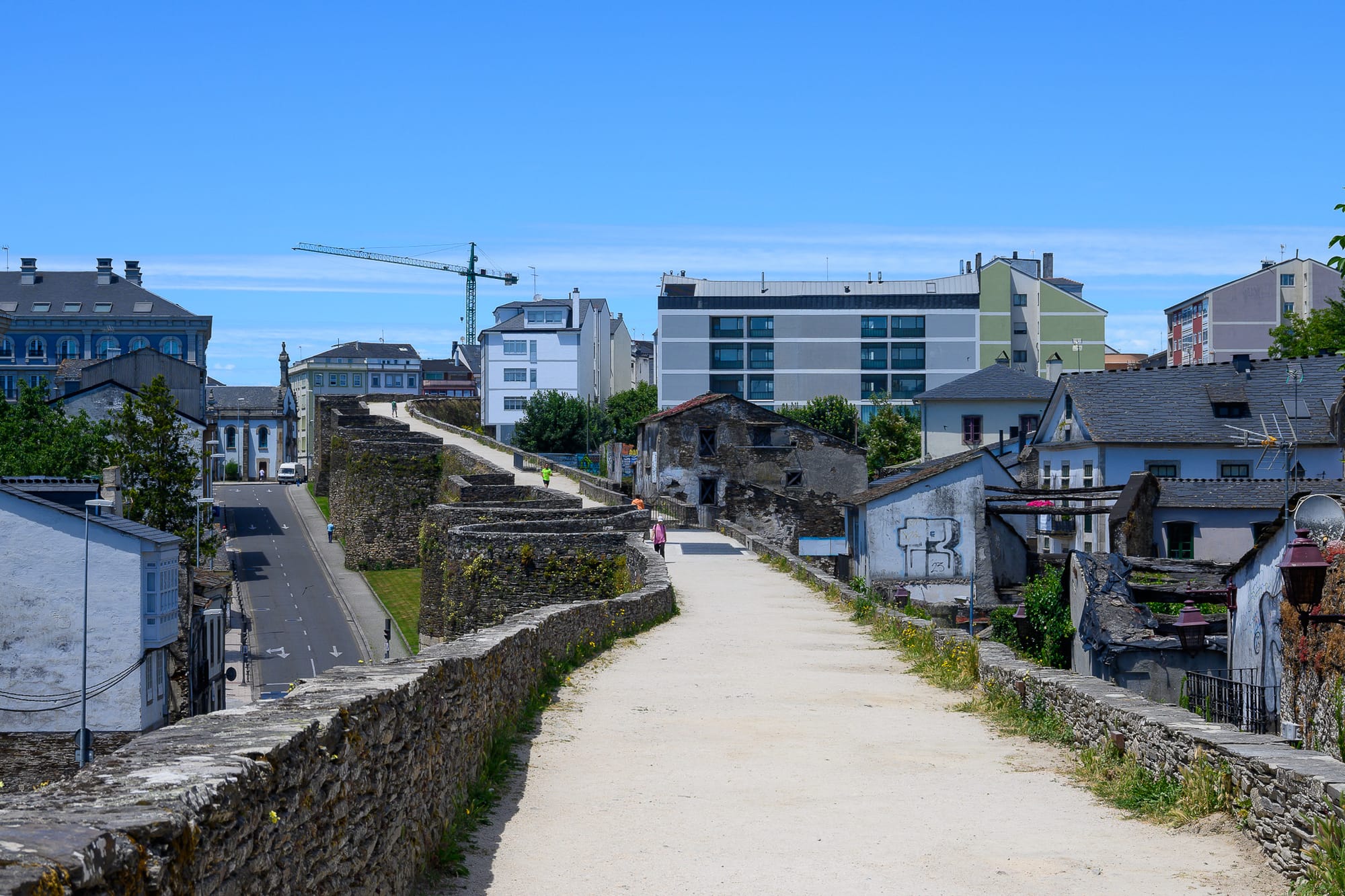Galicia Road Trip Day 2: Lugo

This is part 2 of our road trip to Galicia. If you want to read about the first part in Santiago, please check the link below.

After our morning coffee, we started driving from Santiago to Lugo in the late morning. The plan was to stop somewhere in the middle and possibly grab lunch. We picked Melide for that, right about halfway between the two cities.
The A-54 highway between Santiago and Lugo is not fully complete. There is a stretch of around 40 kilometers where you have to drive on single-lane roads. They are still quite comfortable to drive on. There was little traffic on a Friday, but weekends could be different.

We parked in Melide and started walking around. The most popular Camino route passes through this small town, and when we were there, that was about all the activity happening in town. It was right after noon, and most restaurants were not open yet. We revised our lunch plans to get to Lugo first and eat there.
We were booked in a hotel called Hotel EsteOeste, which is situated inside the old city, inside the old Roman walls, which we will get to later. Our first room smelled a little bit like smoke and a lot like excessive air freshener used to cover the smell of smoke. When we told them, they were happy to change our room. They pointed us towards the main area where tapas bars and restaurants are bunched up. It only took about 10 minutes to get there and another 20 minutes to decide on a place to eat. We settled on trying a pulperia to try the Galician octopus the region is famous for.


We ended up going to a place called Bar Las Cinco Vegas. As usual, I got myself a vermouth—if I remember correctly, it was a Petroni. My wife ordered a tinto de verano, and we were served a couple of tapas—a bit of chorizo and what I think was a Russian salad. We also ordered some grilled squid and Pulpo a Feira. It translates to “fair-style octopus,” a boiled octopus served with salt and paprika and an olive oil drizzle.





We were happy with our meal: nothing groundbreaking, but nothing to complain about, either. After paying our bill, we started walking towards the cathedral and then passing around it to climb the city walls. These walls are the primary attraction of the town. Wikipedia claims that Lugo is the only city in the world to be surrounded by completely intact Roman walls.
They were built around the city in the 3rd and 4th centuries AD, then called Lucus Augusti after its founder. Some sources claim that they were initially constructed to defend against foreign invaders, while others claim that they were more likely built to defend against revolts by local tribes. In either case, they have been incredibly well preserved, extending all around the old town for around 2 kilometers. This made me curious, and I read around a little bit to see why these walls specifically were so well preserved, while most others are in ruins. I learned that Lugo has been continuously occupied since the Roman era and that the walls were regularly maintained and repaired. They were not subjected to major sieges or bombardments either.


Unsurprisingly the walls are recognized as a UNESCO World Heritage Site. It was great to see that they are also part of daily life. If you decide to walk on top of the walls, you'll see many locals just walking and jogging. There are also some large murals painted on the sides of apartments that you can visit during your walk.


After walking around the city, we found ourselves in a park/plaza, sitting on a park bench under shade. Looking at Google Maps, we saw that there is a Bico de Xeado nearby, an ice cream maker my wife had heard about before. They are all over Galicia. We walked there to grab a couple of cups and returned to the park while eating them. These guys make excellent ice cream, and all the flavors are delicious. We sat down, people-watching some more. There were a lot of Americans around for some reason. At first, we saw a few and thought they could be living here, but then more and more started congregating in that park, so we figured it must have been a tour bus or something like that.




The streets were already pretty empty, and we returned to our hotel for some rest and to catch up on our daily stuff. This was the only day during our trip where we did not have a dinner planned, so we also researched that. It came down to two options: Os Cachivaches or Lado, both outside the old town in residential areas. We generally like visiting places like this to get a feeling of where locals (to be fair, more upper-middle-class locals) live and eat. Lado only did tasting menus, which we didn't feel like doing after the fantastic menu we had the day before at Casa Marcelo. If you haven't already, I recommend you read our post about that:

Os Cachivaches is seafood-oriented and famous for its rice dishes. My wife was eyeing the Langostino Kataifi before we even got here. Langostino in Spain is a type of prawn, and for this dish, they come wrapped in Kadaif: thin, fried noodles. We had a very similar fresh dish somewhere else before. While the location is lost to my memory, I remember us liking it quite a bit. Here in Os Cachivaches, they were very good, too. But I'm getting ahead of myself.

We had made a reservation earlier in the day and were shown to our table. The dining room was empty, most likely because only tourists like us show up for dinner at 8:30 PM. Our waiter came over and started speaking Spanish very fast. With smiles and gestures, we indicated that we did not understand. He paused less than half a second to consider this, before continuing to finish whatever he was explaining. We thanked him with our smiles and a nod, and he left us with the menus. Besides the prawns, we also ordered the rice for two, with carabineros (also prawns) and marine plankton. This was the first time we had anything with plankton in it. Apparently, it is a green powder that adds a flavor of, well, the sea.
The rice is similar to Paella, but every region in Spain has slightly different varieties and techniques. This was also brought to the table in a pan. The waiter (a different one) put it on the side and started scraping the sides of the rice to loosen it. Then, he began crushing the heads of the prawns to get the head juice out, to which I responded with an audible gasp, and then he mixed it with the rice. Finally, he served the rice to both our plates, leaving some extra on the pan for whoever wanted to help themselves to some more later. The rice alone was well worth coming to this place. It is very flavourful, creamy, and crunchy at the same time. The prawns were also delicious.



When we finished the food, the first waiter came back and started listing the desserts in Spanish, which we listened intently to. My wife was trying to catch the word “pistachio” in there. She read about their pistachio coulant, and when we didn't hear it, she was brave enough to ask for it. They did have it, and it's a good thing she asked. It was delicious, in a way that you know it can't be good for you.


We started walking back to the old town after sunset, and the street lights were coming on. We saw only a few people as we walked through some residential areas. These parts of Spain feel safe and peaceful, even when walking on deserted city streets at night. As we got closer, we started seeing more and more people making their way to the old town to have fun. We walked around a bit and saw the cathedral again, this time beautifully lit for the evening. The area we visited for lunch was lively again, and it was still getting busier. We were not on Spanish time, so we returned to our hotel for a good night's rest before heading to A Coruña the next day.





